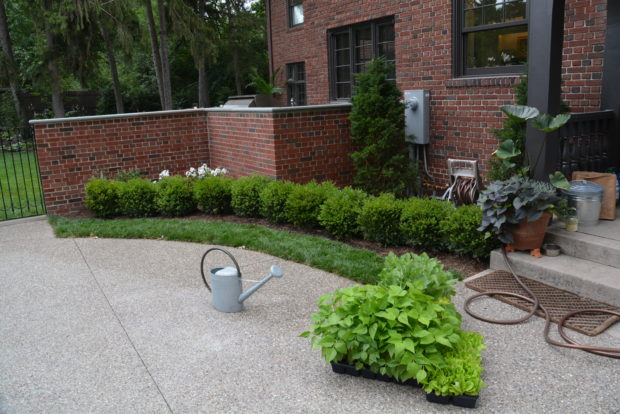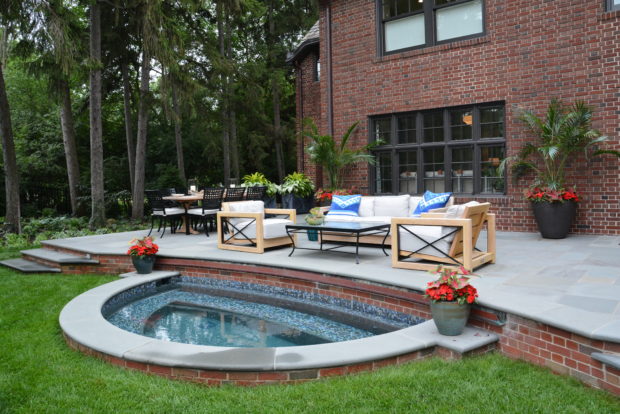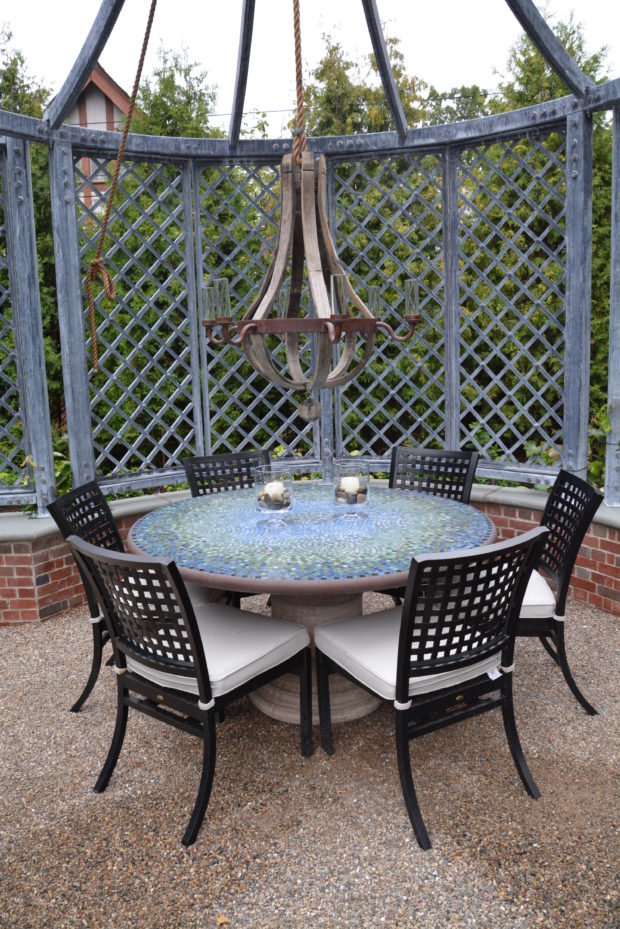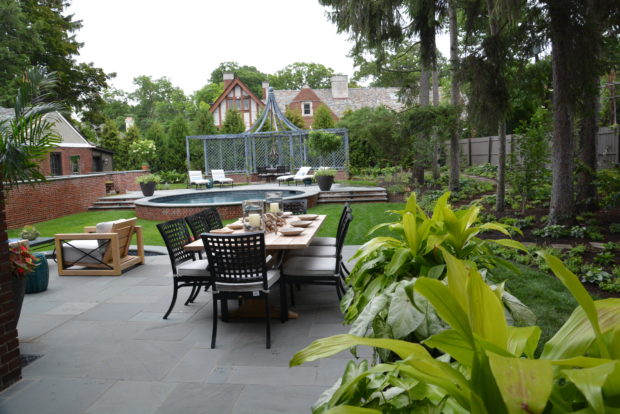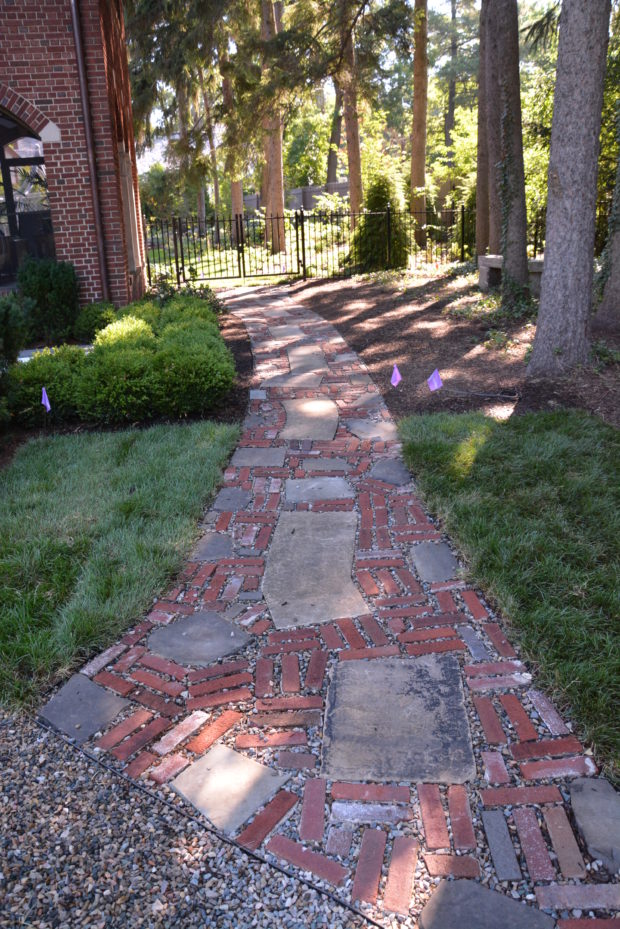 Large growing trees, commonly known as shade trees, take a lot of time and space to achieve a mature size. They need to be carefully sited, as they will eventually tower over a good bit of the square footage around them. The maples that many cities planted at one time or another in the tree lawn – that space between the sidewalk and the street – eventually suffer. Their roots dislike being confined as much as their canopies. Many of those badly placed trees are gone, or in a serious state of decline. Parks are a better place for the biggest growing trees to grow and thrive. But shady streets in the heat of the summer are welcomed by all.
Large growing trees, commonly known as shade trees, take a lot of time and space to achieve a mature size. They need to be carefully sited, as they will eventually tower over a good bit of the square footage around them. The maples that many cities planted at one time or another in the tree lawn – that space between the sidewalk and the street – eventually suffer. Their roots dislike being confined as much as their canopies. Many of those badly placed trees are gone, or in a serious state of decline. Parks are a better place for the biggest growing trees to grow and thrive. But shady streets in the heat of the summer are welcomed by all.
 The shade that trees provide in the landscape is a topic of great interest right now. We have had week after week of glaringly sunny skies and searing heat. Most lawns have turned a parched shade of beige. The temperature at 6am is too hot. Added to that mix – no rain, and no breeze. Our planting taking place in sunny locations is miserable for both the planters and the plantees. Keeping a new planting watered is a next to full time job. Even work that was done weeks ago needs to be monitored closely. A new plant not yet rooted into the surrounding soil can perish quickly if not kept watered. High heat means that water is evaporating from the soil at a rapid rate. A hedge of DeGroot Spire arborvitaes we planted recently is on a drip irrigation system that runs twice a day. The soil was dead dry and dusty down 36″ when we planted. It took over 2 weeks of this irrigation program for moisture to reach down to the bottom of those root balls. I have spent a lot of time on the business end of a hose, both at work and at home. Last but not least, if I am outside for any length of time, I am looking for a shady spot to land.
The shade that trees provide in the landscape is a topic of great interest right now. We have had week after week of glaringly sunny skies and searing heat. Most lawns have turned a parched shade of beige. The temperature at 6am is too hot. Added to that mix – no rain, and no breeze. Our planting taking place in sunny locations is miserable for both the planters and the plantees. Keeping a new planting watered is a next to full time job. Even work that was done weeks ago needs to be monitored closely. A new plant not yet rooted into the surrounding soil can perish quickly if not kept watered. High heat means that water is evaporating from the soil at a rapid rate. A hedge of DeGroot Spire arborvitaes we planted recently is on a drip irrigation system that runs twice a day. The soil was dead dry and dusty down 36″ when we planted. It took over 2 weeks of this irrigation program for moisture to reach down to the bottom of those root balls. I have spent a lot of time on the business end of a hose, both at work and at home. Last but not least, if I am outside for any length of time, I am looking for a shady spot to land.
 The Princeton Gold maples in my yard, pictured above, were originally planted to screen the neighboring properties. This maple is a medium sized tree, meaning that it tops out at about 35 feet. There are lots of smaller growing trees suitable for smaller properties that can endow your landscape with shade. My maples have done a great job of making this part of my yard private. But with that privacy came a lot of shade. At first, that annoyed me. This summer in particular I am enjoying the shade they cast. After work, this shady part of the garden, and the fountain spraying water into the air makes a 90 degree day tolerable. A summer day when I cannot get out into the garden after work is a miserable day indeed. Though I like the freedom of choice that a sunny site provides, there are plenty of reasons to value a shady spot. There are not so many shrubs and perennials that will thrive in shade to this degree. I grow hellebores, sweet woodruff, Japanese Beech ferns, European ginger, pachysandra and yews in this tree dominated garden. It is subdued, and mostly green. It is a fine place to meet and relax on a hot summer day.
The Princeton Gold maples in my yard, pictured above, were originally planted to screen the neighboring properties. This maple is a medium sized tree, meaning that it tops out at about 35 feet. There are lots of smaller growing trees suitable for smaller properties that can endow your landscape with shade. My maples have done a great job of making this part of my yard private. But with that privacy came a lot of shade. At first, that annoyed me. This summer in particular I am enjoying the shade they cast. After work, this shady part of the garden, and the fountain spraying water into the air makes a 90 degree day tolerable. A summer day when I cannot get out into the garden after work is a miserable day indeed. Though I like the freedom of choice that a sunny site provides, there are plenty of reasons to value a shady spot. There are not so many shrubs and perennials that will thrive in shade to this degree. I grow hellebores, sweet woodruff, Japanese Beech ferns, European ginger, pachysandra and yews in this tree dominated garden. It is subdued, and mostly green. It is a fine place to meet and relax on a hot summer day.
 Dogwoods are usually open growing, but this particular tree in my yard is dense in leaf. From the vantage point of my upper deck, the cupped and curling leaves are an expression of distaste for the heat. There is nothing I can do to mitigate the temperature, but I do keep this tree well watered. My decks face east, which means they are shaded by the house in the late afternoon and evening. A terrace you intend to use located on the south or west side of a garden will need a shade scheme. No doubt a canopy of leaves is cooler than an umbrella. To paraphrase from Wikipedia, only 2 or 3 percent of the water plants take up from the soil is used for growth and metabolism. Transpiration or the evaporation of water from stems and leaves is associated with the process of photosynthesis. “Transpiration also cools plants, changes osmotic pressure of cells, and enables mass flow of mineral nutrients and water from roots to shoots”. The transpiration process that governs the life of leaves in the heat of the summer will cool you, too.
Dogwoods are usually open growing, but this particular tree in my yard is dense in leaf. From the vantage point of my upper deck, the cupped and curling leaves are an expression of distaste for the heat. There is nothing I can do to mitigate the temperature, but I do keep this tree well watered. My decks face east, which means they are shaded by the house in the late afternoon and evening. A terrace you intend to use located on the south or west side of a garden will need a shade scheme. No doubt a canopy of leaves is cooler than an umbrella. To paraphrase from Wikipedia, only 2 or 3 percent of the water plants take up from the soil is used for growth and metabolism. Transpiration or the evaporation of water from stems and leaves is associated with the process of photosynthesis. “Transpiration also cools plants, changes osmotic pressure of cells, and enables mass flow of mineral nutrients and water from roots to shoots”. The transpiration process that governs the life of leaves in the heat of the summer will cool you, too.
 A pair of magnolia planted on either side of my driveway have grown together overhead, and shade this spot in the drive. If I park my car here on a hot sunny day, the time it takes to cool off is vastly less that if I had parked it in the sun. Though it was 95 degrees the day I took this picture, it even looks cooler. Extreme and long standing heat is a deterrent to gardening, but it can also be a call to provide shelter.
A pair of magnolia planted on either side of my driveway have grown together overhead, and shade this spot in the drive. If I park my car here on a hot sunny day, the time it takes to cool off is vastly less that if I had parked it in the sun. Though it was 95 degrees the day I took this picture, it even looks cooler. Extreme and long standing heat is a deterrent to gardening, but it can also be a call to provide shelter.
 A staircase going to the kitchen door has a less dense canopy of shade, cast by a pair of dogwoods. There are plenty of plants that tolerate this level of light. In addition to the usual hostas and ferns, I am also able to grow campanulas, lady’s mantle, and acanthus.
A staircase going to the kitchen door has a less dense canopy of shade, cast by a pair of dogwoods. There are plenty of plants that tolerate this level of light. In addition to the usual hostas and ferns, I am also able to grow campanulas, lady’s mantle, and acanthus.
 A shade garden holds its moisture much longer than a garden in full sun. A thorough soaking once in a while is all it needs. An established garden sheltered by trees can take advantage of moisture in the soil around it. An irrigation system or sprinkler is fine for maintaining an adequate level of moisture in the soil. This is not to say that the most established of trees do not suffer during periods of no rain. The interior leaves of many shade trees will turn yellow, and drop, when the soil is too dry. The tree will jettison interior leaves in an effort to conserve what precious little water there is for those outer leaves that actively photosynthesize. Our little leaf lindens at the shop drop interior leaves the moment they are dissatisfied with our sandy too well draining soil. We water them with a small rotating sprinkler called a poppy, made by Nelson. Our version is every bit of 20 years old. Poppy Sprinkler It can be turned down such that all of the water your tree needs will soak in. London Plane trees are notorious for dropping their leaves in hot and dry weather. Their larger than life leaves have more opportunities to transpire.
A shade garden holds its moisture much longer than a garden in full sun. A thorough soaking once in a while is all it needs. An established garden sheltered by trees can take advantage of moisture in the soil around it. An irrigation system or sprinkler is fine for maintaining an adequate level of moisture in the soil. This is not to say that the most established of trees do not suffer during periods of no rain. The interior leaves of many shade trees will turn yellow, and drop, when the soil is too dry. The tree will jettison interior leaves in an effort to conserve what precious little water there is for those outer leaves that actively photosynthesize. Our little leaf lindens at the shop drop interior leaves the moment they are dissatisfied with our sandy too well draining soil. We water them with a small rotating sprinkler called a poppy, made by Nelson. Our version is every bit of 20 years old. Poppy Sprinkler It can be turned down such that all of the water your tree needs will soak in. London Plane trees are notorious for dropping their leaves in hot and dry weather. Their larger than life leaves have more opportunities to transpire.
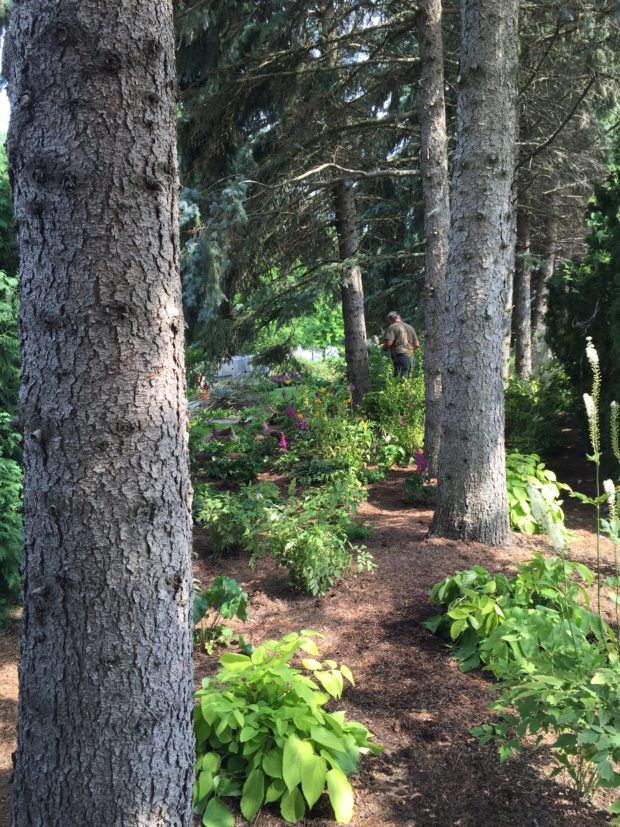 We have been in the process of planting a large shade garden for a client. The area is large enough for kerria japonica pleniflora, aralia cordata Sun King, thalictrums, and dwarf oak leaf hydrangeas. The dappled light means we have a wide range of plants that will thrive here. No small amount of the installation has been the watering in. We watered again today. And celebrated a few hours of rain this afternoon.
We have been in the process of planting a large shade garden for a client. The area is large enough for kerria japonica pleniflora, aralia cordata Sun King, thalictrums, and dwarf oak leaf hydrangeas. The dappled light means we have a wide range of plants that will thrive here. No small amount of the installation has been the watering in. We watered again today. And celebrated a few hours of rain this afternoon.
 Not only will this garden be lovely when it has some age, it was a relief to have some shade during the planting. Though the irrigation for this garden will be installed this Tuesday next, every plant will need water directly to their root balls until they have had time to grow roots into the surrounding soil. New plants need lots of hand watering. The old spruce are a huge help. They take the brunt of the sun and heat, and protect the new plants underneath them.
Not only will this garden be lovely when it has some age, it was a relief to have some shade during the planting. Though the irrigation for this garden will be installed this Tuesday next, every plant will need water directly to their root balls until they have had time to grow roots into the surrounding soil. New plants need lots of hand watering. The old spruce are a huge help. They take the brunt of the sun and heat, and protect the new plants underneath them.
 Milo’s long black fur coat looks hot as blazes. He is not a fan of this heat. He is much happier when we have 28 degree weather. Though I know that fur to a point insulates him from the heat, he has a considerable appreciation for a shady place. Wherever he can get it. The gardener in me is taking a cue from him.
Milo’s long black fur coat looks hot as blazes. He is not a fan of this heat. He is much happier when we have 28 degree weather. Though I know that fur to a point insulates him from the heat, he has a considerable appreciation for a shady place. Wherever he can get it. The gardener in me is taking a cue from him.





